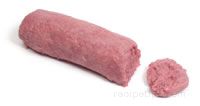The theory of making Forcemeat is to first use a meat that serves as the base ingredient to provide the body and flavor of the item being prepared. Fat, which may be attached to the meat or may be separate is used to enhance the richness of the food as well as to provide a smooth textured substance. The final ingredient is the seasonings that add flavor, texture and binding qualities to the substance. Additional binders may be required separately or in combination that may include eggs, the whites of eggs, bread, flour, rice, dry milk, and/or heavy cream. If bread or flour is used, it is referred to as a "panada" as this ingredient that works as an emulsion to bind the ingredients. Garnishes are the final ingredient if desired, which could include nuts, diced meats, bits of vegetables, or dried fruits. The garnishes are not ground with the base ingredients but added later after the Forcemeat has been fully mixed and ground. After the Forcemeat has been prepared, it is most often placed into a mold which may be a pan similar to a loaf pan that is also known as a terrine or formed into a round mold that may contain a decorative embossing. The term Forcemeat may also be used in reference to ground meat that is forced into a casing when making sausage.
Loading
Forcemeat
A type of seasoned, chopped or blended meat that is used as an ingredient for stuffing’s, appetizers, and main dishes such as meatballs, pâtés, galantines, or terrines. Uniform in texture and firm enough to be cut into individual slices, Forcemeat is categorized into four distinct types: Mousseline-style Forcemeat, Straight Forcemeat, Country-style Forcemeat, or Gratin Forcemeat. The Mousseline-style uses meats or fish such as salmon, chicken, or goose are mixed with cream and eggs to produce the food dish. For Straight Forcemeat a lean meat which is typically pork or veal is ground with fatback to produce the result. Country-style Forcemeat which will not have the finer texture of other Forcemeats, will be coarser like a country-style meat as it combines meat with liver and fat or fatback to add a distinctive flavor to the food. In preparation, the liver is most often forced through a sieve to remove the membrane, sinew or fiber within the meat. Gratin Forcemeats differ from other Forcemeats by the preparation method used to cook the meat. For Gratin Forcemeats, the meat is first cooked by searing it and then allowing it to cool. After cooling the meat is added to the other ingredients and ground together.
There currently aren't any reviews or comments for this term. Be the first!
Advertisement
Advertisement








